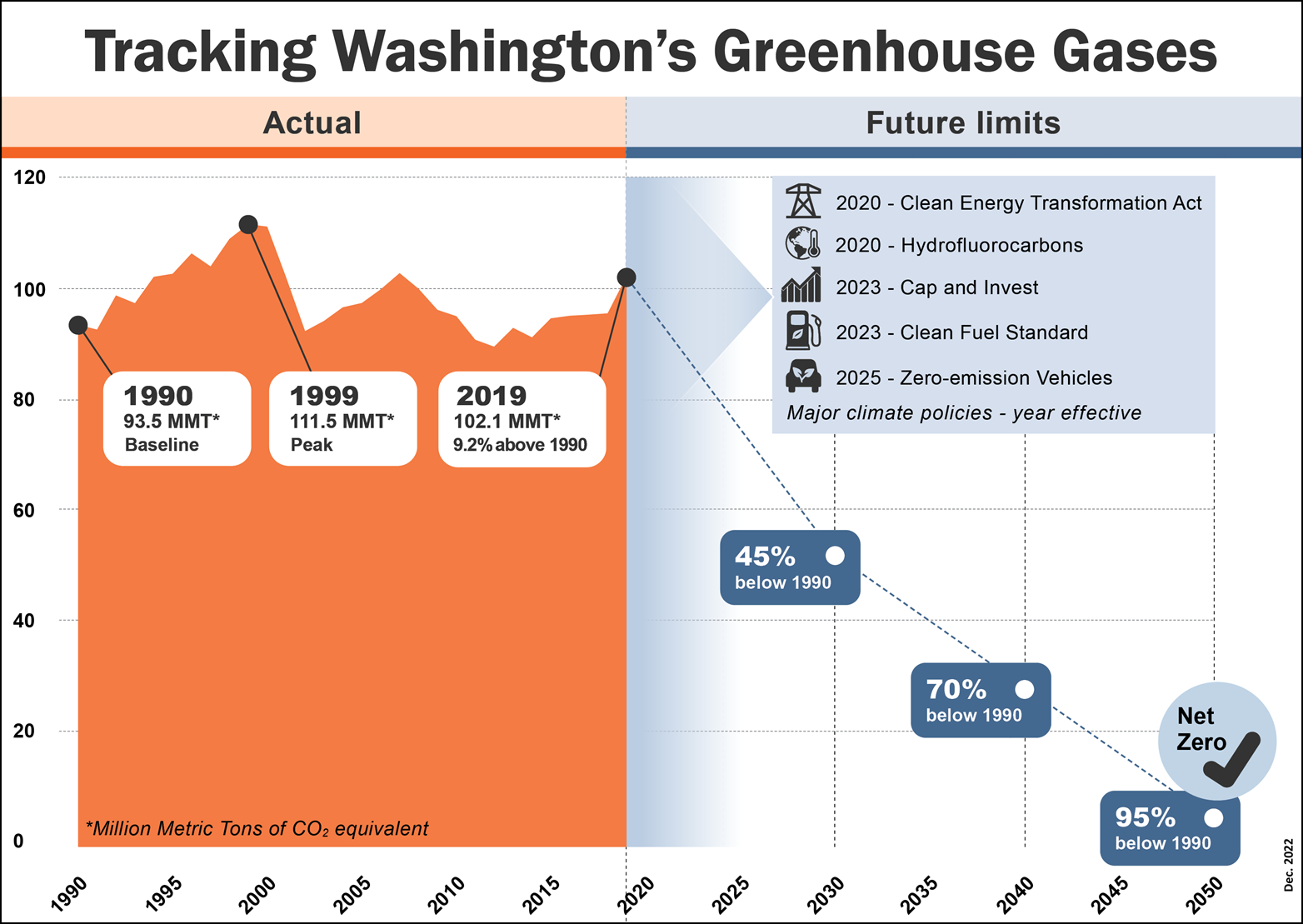The latest data available in Washington’s inventory of greenhouse gas emissions shows statewide emissions rose in 2019, reaching their highest mark since 2007. The rise stems from increased electricity demand combined with an unusually poor year for hydropower in Washington. Less water behind the state’s dams in 2019 pushed utilities to use fossil fuel generation to make up the difference.
The silver lining in the 2019 data is that total emissions remained well below their all-time peak in 1999, and that preliminary 2020 data shows the increase is likely to be short-lived, said Joel Creswell, climate policy section manager with the Washington Department of Ecology. Ecology compiles the latest available data into a report every two years.
“The increase in emissions is a stark reminder of just how important it is for Washington to take bold action to cut emissions and protect our water supplies, forests, environment, economy and people from the effects of climate change,” Creswell said.
Emissions data shows progress – and challenges – in meeting targets
Ecology uses a combination of state and federal data to assemble an emissions inventory that meets national standards, but this nationwide data typically comes with a significant lag time in reporting. The emissions inventory is still an important tool because it offers the most complete accounting currently possible of every emissions category in the state.
Despite emissions rising 6.9% from 2018 to 2019 to reach 101.2 million metric tons of carbon dioxide equivalent, they remained significantly below the all-time peak in 1999 of 111.5 million metric tons. Since that peak, Washington’s population has grown steadily, and its economy has consistently ranked amongst the strongest in the nation. That means per capita emissions have decreased over the past 20 years, and that fewer emissions are required for every dollar generated by Washington’s economy.
Emissions rose in 2019 in Washington, but the economy and population have grown more quickly than emissions over the past two decades, meaning the state is decarbonizing.
“It’s remarkable how successful Washington has been in growing our economy and decarbonizing at the same time,” Creswell said. “Yet, in order to meet the emission limits set in state law, we need to turn the corner quickly and sharply cut carbon pollution.”
Research indicates eliminating greenhouse gas emissions is necessary to prevent the worst effects of climate change. Washington law requires statewide emissions to fall 45% below 1990 levels by 2030, 70% by 2040, and finally reach net zero by 2050.
What future emissions inventories will show
The 2019 data should represent an inflection point in Washington emissions. Preliminary data for the electricity sector in 2020 suggests emissions went down that year due to improved hydropower conditions and a decline in electricity demand tied to the Covid-19 pandemic.
In recent years, Washington Gov. Jay Inslee and the Legislature have passed several new laws to cut emissions. The Clean Energy Transformation Act that passed in 2019 requires all electricity used in Washington to come from renewable, or non-emitting, sources by 2045. Achieving that target will mean that, in the future, a bad water year like 2019 will not result in the same rise in emissions.
Two more major carbon reduction policies will take effect Jan. 1 – the Climate Commitment Act’s "cap-and-invest" program and the Clean Fuel Standard.
The state's new cap-and-invest program requires major sources of carbon pollution to obtain allowances equal to their emissions. The total number of allowances is capped, and the cap will be reduced over time, pushing facilities and businesses to find ways to cut emissions.
The proceeds generated by auctions will be a significant tool to further decarbonize the economy. These funds must be invested by the Legislature in projects focused on improving clean transportation, increasing climate resilience in ecosystems and communities, and addressing issues of environmental justice and health inequity across Washington.
The Clean Fuel Standard is a complementary policy to the Climate Commitment Act. It focuses on transportation fuels – the largest category of emissions in Washington. It requires fuel suppliers to reduce the carbon intensity of their products 20% by 2034 – eventually cutting statewide emissions by 4.3 million metric tons of carbon dioxide equivalent a year.
The Clean Fuel Standard is already attracting new investments in renewable fuels and expanding charging networks for electric vehicles.
“We have strong policies in place to cut carbon pollution, and we’re confident Washington is on the right path,” Creswell said. “But it will still take time for the effects of those laws to show up in future inventory releases.”



